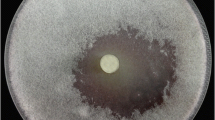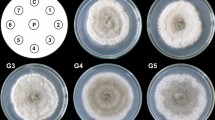Abstract
Sclerotia, the survival stage of Aspergillus flavus, are compact masses of mycelia capable of with-standing harsh climatic conditions. Six strains of Paecilomyces lilacinus, originally isolated from sclerotia of A. flavus var. flavus or A. flavus var. parasiticus, were also able to colonize the sclerotia from four different strains of A. flavus under laboratory conditions. P. lilacinus strains did not differ significantly in their colonization ability, but host susceptibility appeared to be an important factor. P. lilacinus strains were cultured in vitro for 96 h on a basal salt medium containing either ground sclerotia of A. flavus or glucose plus asparagine. Activities of hydrolytic enzymes such as polysaccharidases, proteases, and chitinases were determined in the culture supernatants. Supernatants from fungal cultures grown in the basal medium containing glucose plus aspargine medium showed very little or no enzyme activity, whereas fungi grown on ground sclerotia produced a variety of enzymes. Specifically, all strains produced chitinases (endochitinase and N-acetyl glucosaminidase), β-1,3-glucanase, chymoelastase and chymotrypsin, suggesting that these enzymes may be required for colonization of sclerotia. Production of β-1,4-glucanase, dextranase, cellulase, and trypsin was strain variable, suggesting that these enzymes may not be required.
Similar content being viewed by others
References
Bojovic-Cvetic D, Vujicic R (1988) Polysaccharide cytochemistry in maturing Aspergillus flavus sclerotia. Trans Br Mycol Soc 91:619–624
Bradford M (1976) A rapid and sensitive method for the quantification of microgram quantities of proteins utilizing the principle of protein-dye-binding. Anal Biochem 72:248–254
Diener UL, Cole RJ, Sanders GA, Payne GA, Lee LS, Klich MA (1987) Epidemiology of aflatoxin formation by Aspergillus flavus. Annu Rev Phytopathol 25:249–270
Domsch KH, Gams W, Anderson TH (1980) Paecilomyces. In: Compendium of soil fungi. Academic Press, London, pp 530–532
Galvez-Mariscal A, Lopez-Munguia A (1991) Production and characterization of a dextranase from an isolated Paecilomyces lilacinus strain. Appl Microbiol Biotechnol 36:327–331
Gomez-Miranda B, Leal JA (1981) Extracellular and cell wall polysaccharides of Aspergillus alliaceus. Trans Br Mycol Soc 76:249–253
Gupta SC, Leathers TD, El-Sayed GN, Ignoffo CM (1991) Production of degradative enzymes by Metarhizium anisopliae during growth on defined media and insect cuticle. Exp Mycol 15:310–315
Jain S, Parriche M, Durand H, Tiraby G (1990) Production of polysaccharides by a cellulase-pectinase hyperproducing mutant (Pol6) of Penicillium occitanis. Enzyme Microb Technol 12:691–696
Karhuvaara L (1960) On the parasites of the sclerotia of some fungi. Acta Agric Scand 10:127–134
Kelly CT, O'Mahony MR, Fogarty WM (1989) Extracellular xylanolytic enzymes of Paecilomyces varioti. Biotechnol Lett 11:885–890
Leathers TD (1986) Color variants of Aureobasidium overproduce xylanase with extremely high specific activity. Appl Environ Microbiol 52:1026–1030
Makkonen R, Pohjakallio O (1960) On the parasites attacking the sclerotia of some fungi pathogenic to higher plants and on the resistance of these sclerotia to their parasites. Acta Agric Scand 10:105–126
Saksirirat W, Hoppe HH (1990) Verticillium psalliotae an effective mycoparasite of the soybean rust fungus Phakopsora pachyrhizi Syd. Z Pflanzenkr Pflanzenschutz 97:622–633
Saksirirat W, Hoppe HH (1991a) Secretion of extracellular enzymes by Verticillium psalliotae Treschow and Verticillium lecanii Zimm. Viegas during growth on uredospores of the soybean rust fungus Phakopsora pachyrhizi Syd. in liquid cultures. J Phytopathol 131:161–173
Saksirirat W, Hoppe HH (1991b) Degradation of uredospores of the soybean rust fungus Phakopsora pachyrhizi Syd. by cell-free culture filtrates of mycoparasite Verticillium psalliotae Treschow. J Phytopathol 132:33–45
Shotwell OL (dy1977) Aflatoxin in corn. J Am Oil Chem Soc 54:216A–224A
Sun J, Cheng X, Zhang Y, Yan Z, Zhang S (1988) A strain of Paecilomyces lilacinus producing high quality dextranase. Ann N Y Acad Sci 542:192–194
Wicklow DT (1987) Survival of Aspergillus flavus sclerotia in soil. Trans Br Mycol Soc 89:131–134
Wicklow DT (1984) Sporogenic germination of sclerotia of Aspergillus flavus and Aspergillus parasiticus. Trans Br Mycol Soc 82:621–624
Wicklow DT, Shotwell OL, Adams GL (1981) Use of aflatoxin-producing ability medium to distinguish aflatoxin-producing strains of Aspergillus flavus. Appl Environ Microbiol 4:697–699
Wicklow DT, Wilson DM (1990) Paecilomyces lilacinus, a colonist of Aspergillus flavus sclerotia buried in soil in Illinois and Georgia. Mycologia 82:393–395
Author information
Authors and Affiliations
Additional information
The mention of firm names or trade products does not imply that they are endorsed or recommended by the U.S. Department of Agriculture over other firms or similar products not mentioned
Correspondence to: S. C. Gupta
Rights and permissions
About this article
Cite this article
Gupta, S.C., Leathers, T.D. & Wicklow, D.T. Hydrolytic enzymes secreted by Paecilomyces lilacinus cultured on sclerotia of Aspergillus flavus . Appl Microbiol Biotechnol 39, 99–103 (1993). https://doi.org/10.1007/BF00166856
Received:
Accepted:
Issue Date:
DOI: https://doi.org/10.1007/BF00166856




